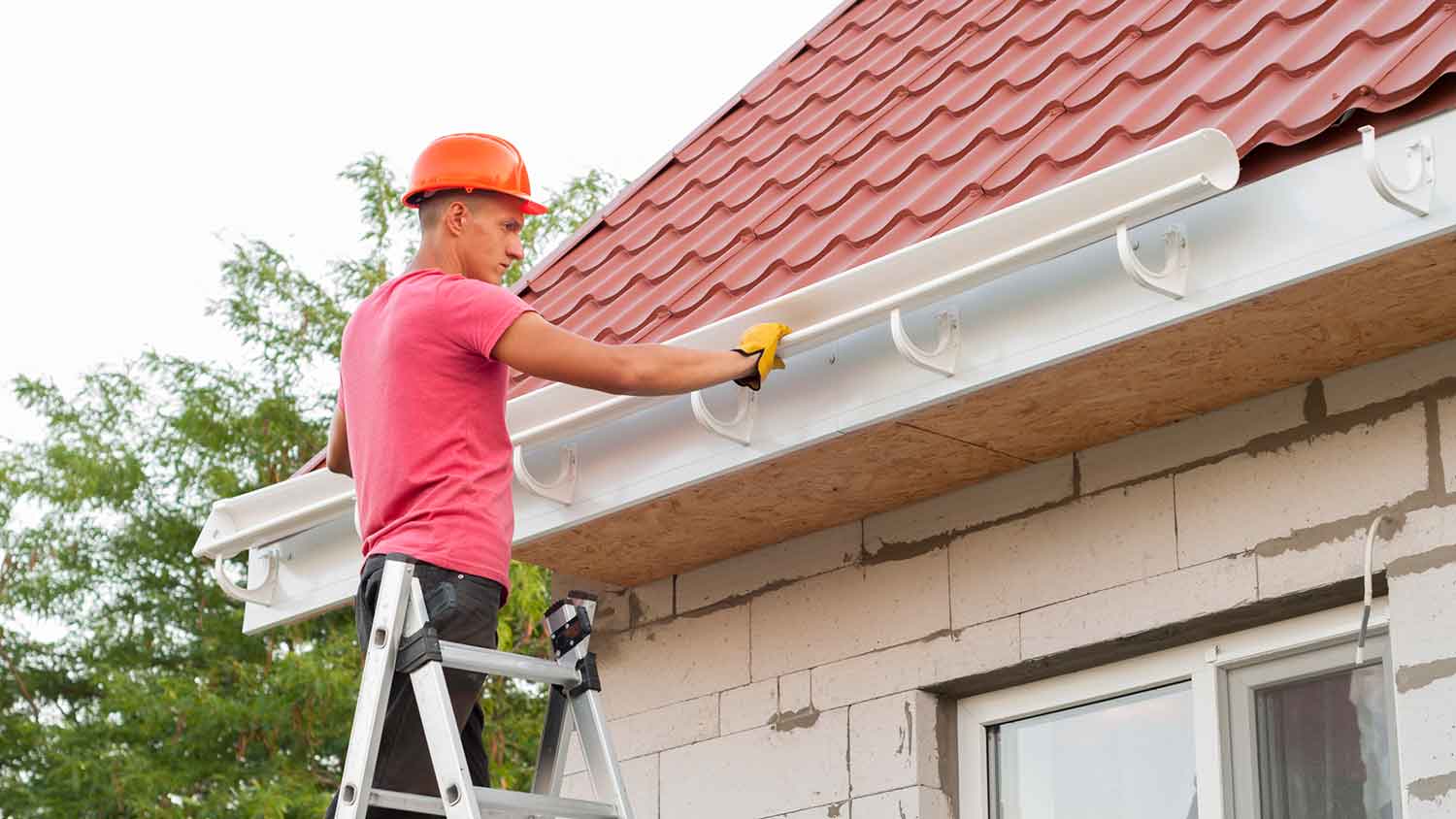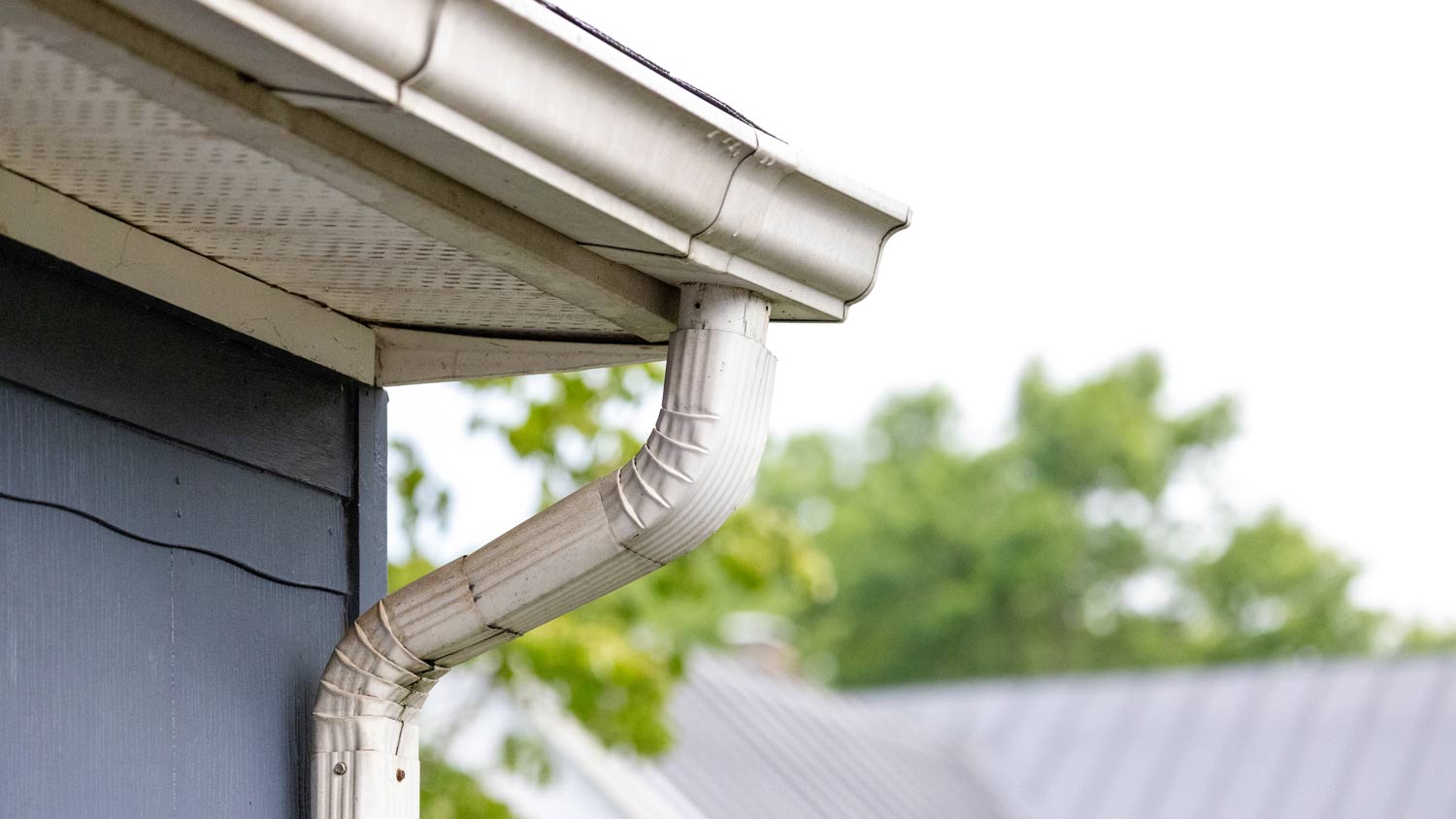
Wondering how much gutter installation costs? We’ll break down prices by material, gutter type, and other factors impacting overall gutter costs.
Keep the water slip-sliding away


The recommended gutter slope is 1/4 inch per 10 feet of gutter length.
Homes with heavy rainfall can have a steeper slope of 1/2 an inch per every 10 feet of gutter.
An optimal gutter slope efficiently moves water through the downspout to prevent damage to your home.
A key feature of your home's drainage system is the gutters, channeling rainwater away from your home to prevent water damage. The gutter's slope must be aligned properly to do its job. An improper slope can lead to water pooling, clogs, and structural issues. For most homes, the ideal gutter slope is 1/4 inch of slope per 10 feet of gutter length—but there are exceptions. Learn how much slope a gutter needs and its important role in your gutter system.
A gutter slope is the slight angle at which a gutter is installed to guide water toward the downspout. This slope uses gravity to move water efficiently, but without the correct slope, water can stagnate in the gutter, leading to debris buildup, mold growth, and overflow.
The consequences of gutters overflowing or failing to drain properly can be severe. Water may pool near your foundation, causing cracks or erosion. Standing water in gutters adds unnecessary weight, straining brackets and leading to sagging or detachment.

The recommended gutter slope is 1/4 inch of slope per 10 feet of gutter length. This subtle incline ensures that water flows steadily without moving too quickly or too slowly.
While most homes can abide by the standard slope, some factors may require adjustments:
Climate: Areas with heavy rainfall benefit from slightly steeper slopes to handle larger volumes of water. Homes that require a steeper slope can have a slope of 1/2 an inch per every 10 feet of gutter.
Roof design: Depending on gutter sizes, complex or unique roof layouts require customized slopes to accommodate multiple downspouts.
Material: Some gutter materials, like vinyl, are more flexible and may need careful adjustments to maintain the correct slope over time.
Without maintaining a proper slope, two main issues can occur: over-sloping and under-sloping. Water moves too quickly with an over-slope, bypassing debris and leaving it behind to clog the gutter. In an under-slope, water pools and stagnates, creating an ideal environment for blockages and damage.
If your gutters aren’t sloped correctly, they may need adjustment. It’s always best to call a gutter professional near you to handle this type of job. But if you have previous experience and are comfortable working at heights, you can follow these steps to adjust gutter slope:
Inspect for problems: Look for common signs of trouble, like standing water, sagging, and frequent clogs.
Loosen the brackets: Loosen the brackets securing the gutter to the fascia using a screwdriver.
Reposition the gutter: Adjust the gutter to create the recommended 1/4 inch slope per 10 feet of length. Use a level to confirm the correct angle.
Secure the brackets: Once the gutter is properly positioned, tighten the brackets.
Test with water: Pour a small amount of water into the gutter and observe the flow. The water should move steadily toward the downspout without pooling.
If you can't adjust your gutter's slope due to significant damage, you'll need to replace them. The average gutter installation cost ranges between $630 and $1,720.
Regular maintenance of your gutters ensures proper function over time. One of the most important tasks is cleaning them at least twice a year, ideally in the spring and fall. A clogged gutter can disrupt the slope’s effectiveness so remove any leaves, twigs, and other debris. Clear any obstructions from the downspout and position it to direct water away from the foundation.
During cleanings, inspect your gutters for cracks, sagging, detached sections, or other signs of damage. Identify and repair these issues promptly to prevent further complications and prolong the gutter system's lifespan. More severe damage could be signs you need a new gutter. Heavy rain or strong winds can alter the slope or create blockages that impede water flow, so always check your gutters after severe weather. A quick inspection ensures any problems are addressed before they escalate.
From average costs to expert advice, get all the answers you need to get your job done.

Wondering how much gutter installation costs? We’ll break down prices by material, gutter type, and other factors impacting overall gutter costs.

This guide will give you an idea of how much you can expect to pay when getting new seamless gutters installed when accounting for removal, labor, and different gutter materials.

Here's everything you ever wanted to know about saving money by installing faux copper gutters instead of real copper gutters.

It's time to say goodbye to clogs in your gutter system. Learn how to clean a gutter downspout safely on your own in a few simple steps.
A gutter is a water manager that channels water away from your home to prevent water damage and other household issues. How long do they last? Let’s find out.

Before investing in a gutter protection system for your home, review micro mesh gutter guard pros and cons to ensure they meet your home’s needs.